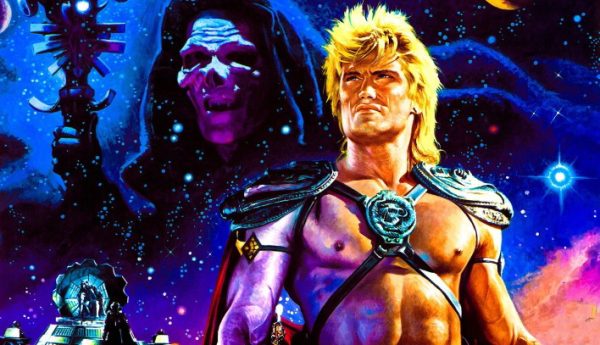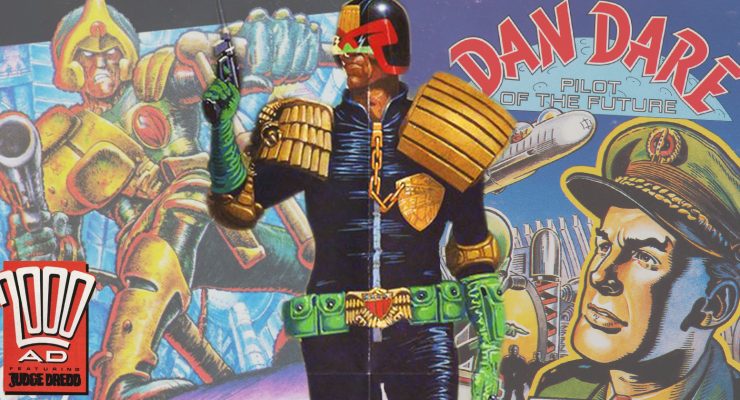Tom Jolliffe looks back at one of Cannon Films’ most iconic movies, Masters of the Universe…
36 years ago, Cannon Films unleashed upon the world a movie adaptation of a long-running kids cartoon and toy line with the release of Masters of the Universe. In the modern era, such a weighty IP and pop culture force would probably result in instant box office gold. Things were a little different in 1987 however.
In fact, Masters of the Universe was at once a sign of Cannon’s lofty ideals to match the big blockbusters of the time blow for blow, but also a first death knell for a company in decline. 1987 saw Cannon spending big, but at the same time only spending a fraction of what they’d originally intended for both Masters of the Universe and Superman IV: Quest for Peace (the latter in particular had substantial budget cuts and boy did it show).
For He-Man’s leap from TV cartoon show to the big screen, Cannon certainly put some financial clout behind the project, even if they’d initially looked to spend more. They’d already spent lofty amounts on films like Lifeforce a year or so prior. They were in dire need of a hit. The project gestated for a while, eventually going to cameras with a plot that would see He-Man come to Earth and subsequently save money on sets. The few sets they did build, such as the Castle Grayskull interior, were suitably impressive. The trouble was by the time the film was ready to hit the US cinemas, the leading man had lost momentum from his breakout role.
Dolph Lundgren broke out huge with Rocky IV, playing the iconic Ivan Drago. In an ideal world, while the buzz was still fresh and his name was passing lips, Masters should have come out a year earlier. On top of that, the cartoon and toy line were both well past the peak of their popularity. The cartoons ran from 1983 to 1985. They were still a regular feature in reruns, but kids by this point had moved on. Likewise, the toys suffered from oversaturation and overkill. They pumped out a ridiculous amount of new characters, some of which would only appear once in the cartoon. You can have too much of a good thing (Marvel and Disney take note). So we had a He-Man movie hitting theatres too far past the source material’s peak.
Messers Golan and Globus of Cannon Films always had the gift of the gab when it came to promotion. The trouble is, sometimes they thought that their vociferous showmanship alone could be enough. There wasn’t enough of a push to really promote Masters of the Universe like it needed, to compete with rivals. The film was facing Stakeout at the box office, as well as continuing runs for The Living Daylights and The Lost Boys. Despite a passable opening, it underperformed in the US, the key market.
The film was also hammered by critics due to the cop-out storyline that saw He-Man coming to Earth, the omission of several key characters from the original show (and slightly misfiring replacements like Gwildor instead of Orko). Dolph Lundgren wasn’t given much praise at all, particularly as the wont of critics during that era was to, by default, hammer anyone with big biceps and a six-pack. Some of his dialogue couldn’t quite disguise the remains of his Swedish accent either.
Still, there were positives. Like many Cannon productions, Masters is an odd mish-mash of impressive production and effects, and others which look cheap. Cannon collected a lot of crew members from Star Wars in the production/sets and visual FX departments, and also had Anne Coates (Lawrence of Arabia) editing it. For all the things that didn’t work, there were sets, costumes, and FX which did. Then there was theatrically trained actor, Frank Langella playing a Shakespearean villain version of Skeletor, intent on universal domination. For critics, he was a bright spot in an otherwise rote kids’ film.
Then there was me. I had to wait until Boxing Day 1987 for the film to fly its way over to the UK. I was a massive He-Man fan. As soon as I got wind of a movie version (if I recall, I caught sight of a TV spot announcing its imminent arrival) it was a must-see. For many fans the Earth setting and lack of Eternia, Orko, Adam, Cringer/Battlecat, etc, was a point of contention. For just as many though, we welcomed the changes. We could separate toys, cartoon and movie.
The darker designs of the costumes and less colourful visuals just made Dolph’s He-Man feel more inherently real. The film is still bolstered with plenty of contrast and colour. The production sought to overcome the restrictive budget by thinking outside the box. One such decision was to place a lot of neon lighting incidentally in the mise-en-scene. Dolph was suitably imperious, if mostly physically. Skeletor was effectively intense, a complete antithesis to the bumbling boob we’d known from the cartoons. His makeup also chilling, like something out of a horror movie.
So I watched the film on the big screen and loved it. The following Christmas my Nan bought me the VHS (to this day one of the best presents I’ve ever received). In return, I wore the tape to within an inch of its life. I loved Masters of the Universe. It became my most childhood-defining film and a favourite for many years. Additionally, Dolph was my childhood hero. Ironically, I’d previously had an aversion to him as a Rocky fan, naturally hating him as the villain from Rocky IV, however, it was a few years until I recognised Lundgren as being both characters.
Time might have made me see a few flaws, but hasn’t diminished my appreciation of Masters of the Universe. I’ve always loved the score (Bill Conti) and still listen regularly. Then a few years ago I managed to catch a big screen showing at the Prince Charles Cinema in London. For the uninitiated, they regularly show old greats, classics, iconic films and B movies. 80’s stuff is wildly popular there and always has a great atmosphere.
Something remarkable struck me whilst rewatching with a mixture of nostalgic folk my age, and youngsters likely discovering this for the first time. The film is great fun to watch. It’s funny. Sometimes it’s got that so bad its good element, but it’s also intentionally funny. It was made in good spirit with an all-hands-on-deck approach to making a film that has ideas beyond its financial means. We’re in an age where Marvel films have been the in thing, and structurally and even tonally, there are a lot of MCU-flourishes in Masters of the Universe which the younger crowd probably picked up on (whilst happy to forgive the roughness of the old style compositing and iffy mattes).
The B-movie lovers watching ironically were getting plenty, the nostalgia hounds also, but the ones welcoming what the film was offering on genuine terms, were entertained too. It has aged quite well, like many flawed 80’s fantasy classics because it has artistic merits (like many of the aforementioned production elements and score) that are worthy of praise. Langella’s Skeletor too, evoked great reactions from the crowd. A perfect mix of pantomime villain, theatrical scenery chewer and intensely threatening presence. They loved him.
For many Cannon aficionados, Masters of the Universe was a key film from their childhood. It often ranks high in the lists of Cannon fans and is often one of the films that kick-started their love affair with the affably haphazard studio. It’s gone from being an example of bad cinema, looked down upon, to something with a lot more appreciation (even for those who watch bad films for entertainment, something that has really reawakened in the internet age). It might be 36 years on, but the film is remembered fondly, attracts regular interest at cons and conventions, has plenty of retrospective screenings around the world, and has probably never been more popular.
SEE ALSO: The Essential Cannon Films Scores
What are your thoughts on Masters of the Universe? Let us know on our social channels @flickeringmyth…
Tom Jolliffe is an award-winning screenwriter and passionate cinephile. He has a number of films out around the world, including When Darkness Falls, Renegades (Lee Majors and Danny Trejo) and War of The Worlds: The Attack (Vincent Regan), with more coming soon including Cinderella’s Revenge (Natasha Henstridge) and The Baby in the Basket (Maryam d’Abo and Paul Barber). Find more info at the best personal site you’ll ever see here.


















